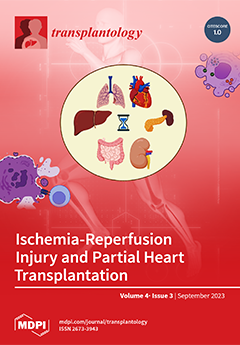Open AccessArticle
A Combination of Cytological Biomarkers as a Guide in the Diagnosis of Acute Rejection in Lung Transplant Recipients
by
Silvia Aguado Ibáñez, Rosalía Laporta Hernández, Myriam Aguilar Pérez, Christian García Fadul, Cristina López García Gallo, Gema Díaz Nuevo, Sonia Salinas Castillo, Raquel Castejón Diaz, Clara Salas Anton, Ana Royuela Vicente, Francisco Antonio Bernabeu Andreu and María Piedad Ussetti Gil
Viewed by 942
Abstract
The usefulness of bronchoalveolar lavage fluid (BALF) to support the diagnosis of acute cellular (ACR) rejection in lung transplant (LTX) recipients remains controversial. ACR has been associated with blood eosinophil counts (EOS) in other solid organ recipients, but there are few studies in
[...] Read more.
The usefulness of bronchoalveolar lavage fluid (BALF) to support the diagnosis of acute cellular (ACR) rejection in lung transplant (LTX) recipients remains controversial. ACR has been associated with blood eosinophil counts (EOS) in other solid organ recipients, but there are few studies in relation to lung transplants. Our aim was to assess the usefulness of the combined analysis of BALF cellularity and EOS for the diagnosis of ACR in lung transplant recipients. This is a retrospective study of findings observed simultaneously in 887 transbronchial biopsies (TBB), BALF, and blood samples obtained from 363 LTx patients transplanted between 2014 and 2020. The variables collected were: demographics, ACR degree, BALF cellularity, and simultaneous blood EOS counts. The lymphocyte count in BALF was significantly higher in patients with ACR than in those without (11.35% vs. 6.11%;
p < 0.001). In parallel, EOS counts were also significantly higher in patients with ACR than in the non-ACR group (EOS 213 ± 206/mm
3 vs. 83 ± 129/mm
3;
p < 0.001). Increases in both parameters were associated with an increased risk of ACR (lymphocytes OR 1.100; 95% CI 1.080–1.131; EOS OR 1.460; 95% CI 1.350–1.580). The diagnostic specificity of ACR for a lymphocyte count > 12% was 71.1%, which increased to 95.8% when taking into account a simultaneous blood EOS count > 200/mm
3. Simultaneous assessment of BALF lymphocyte counts and blood eosinophil counts may be useful for diagnosing ACR in patients with risk factors for TBB or in the presence of inconclusive histological samples.
Full article
►▼
Show Figures




